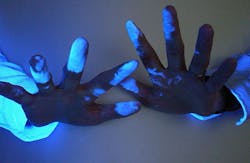According to the most recent edition of the annual National Retail Security Survey (NRSS) published last June, retail shrink topped $50 billion in 2018 for an average of 1.38% of all sales for the year. The report found that robberies accounted for the largest losses per incident at an average $2,885.15, followed by employee theft at $1,264.10 and shoplifting/organized retail crime at $546.67.
Historically, retailers have devoted most of their loss prevention resources to technology that protects merchandise itself rather than on apprehending the culprits. For example, the NRSS found that 46% of retailers were using merchandise alarms/electronic security tags, while 35% reported using acousto-magnetic security tags.
However, some companies have started to develop solutions that seek to identify the perpetrators of retail crime which they believe will have a greater deterrent effect than the industry has thus far seen with merchandise alarms. One such company on the frontline of these efforts is SelectaDNA which tags criminals with a uniquely identifiable spray.
“What we simply are is a forensic marking technology. Every unit of the forensic solution we make has a unique code in it, it’s never replicated… so when it’s applied under certain circumstances – either the person or the item – we can tell where they were marked, and the date and time they were marked,” explains Joe Maltese, Vice President of Marketing and Operations for CSI Protect, the company that is distributing SelectaDNA in the U.S. “It’s providing irrefutable evidence to law enforcement that links a person or item to a crime scene. You can think of it as an invisible serial number that stays on your skin for four to six weeks and on your clothing for a couple of months.”
Within European countries where the company’s technology has been available for nearly a decade, Maltese says retailers that have deployed SelectaDNA have experienced crime reductions ranging between 40% of the low end to as much as 86% on the high end.
“If you can reduce the risk of getting robbed by 70%, that’s really significant and that’s the results we’re getting in Denmark,” says Henrik Friborg Jacobsen, an investor in SelectaDNA who is also a co-founder and board member at Milestone Systems.
Easy Installation
In stores where SelectaDNA is deployed, when a cashier is robbed, the system can be deployed by simply removing money within the cash drawer in a certain way, at which point spray heads installed at thresholds of the retailer’s entry and exit points will dispense a mist, invisible to the naked eye, on the perpetrator as they exit.
“It’s highly programmable. There’s a control box, then the spray heads – the spray can be deployed in the ceiling, wall, doorway, above the point of sale, above safes, or wherever you want it based on situation, be it a burglary, robbery, theft, unauthorized access, etc.,” Maltese adds. “For example, in a robbery, a person can hit a panic button and when a person is going out, wherever the motion sensor is installed, that’s where it will go off. It’s a very fine, invisible mist and you won’t know you’re getting sprayed.”
According to Maltese, the company is now moving beyond these typical standalone types of deployments and is starting to be integrated with access control and video management systems. Among the first VMS solution SelectaDNA has integrated with is Milestone, which they highlighted in their booth at the recent Milestone Integration Platform Symposium (MIPS) in Dallas, Texas.
“Now we’re able to design a total integration,” he says, adding that their solution can now be “remotely or internally activated based on the use of video surveillance or program a rule to do it automatically based on a sensor.”
Proven Results
Within Copenhagen, Jacobsen says that approximately half of the supermarkets have this technology installed and that they have experienced “quite impressive” results with regards to crime reduction. “There has been a huge decrease in violent crime due to the DNA remote tagging system,” adds Henrik Olsen, CEO of CSI Protect.
The company currently has active deployments in the tens of thousands across 35 different countries with approximately 1,000 systems in Denmark alone, according to Olsen.
“Even though it is new to the U.S. market, it is a mature technology,” Jacobsen says. “It has proven that it works and that’s what I liked being an investor in this venture; we’re not reinventing the wheel, it’s bringing the technology to the market.”
Joel Griffin is the Editor-in-Chief of SecurityInfoWatch.com and a veteran security journalist. You can reach him at [email protected].About the Author
Joel Griffin
Editor-in-Chief, SecurityInfoWatch.com
Joel Griffin is the Editor-in-Chief of SecurityInfoWatch.com, a business-to-business news website published by Endeavor Business Media that covers all aspects of the physical security industry. Joel has covered the security industry since May 2008 when he first joined the site as assistant editor. Prior to SecurityInfoWatch, Joel worked as a staff reporter for two years at the Newton Citizen, a daily newspaper located in the suburban Atlanta city of Covington, Ga.

